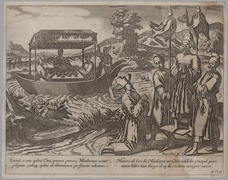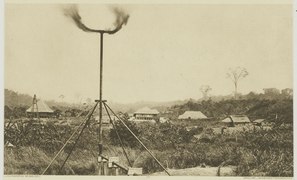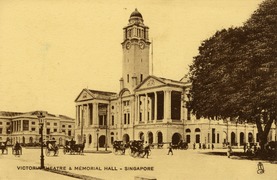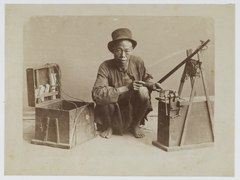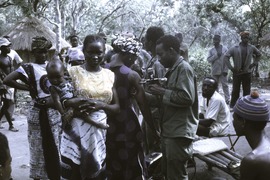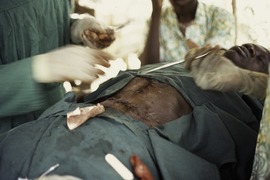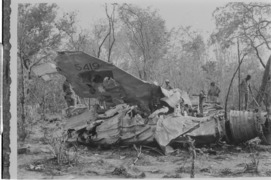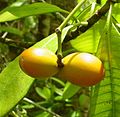GLAM/Newsletter/May 2016/Single
Joburg, Côte d’Ivoire, Cameroon, Nigeria and Ghana
KickStart meeting in Joburg for the Wiki Loves Women project
The Wiki Loves Women Project : encouraging the contribution of quality information on African women to be published on, and made widely available via, Wikipedia


In May 2016, the Wikimedians involved in WLW (Florence Devouard, Isla Haddow-Flood, Geugeor, Dominique Eliane Yao, Rberchie, and Olaniyan Olushola), met at the Goethe Institut in Johannesburg (South Africa) with Brigitte Doellgast (Head of Library & Information Services, GI) for a face to face meeting.
We had 3 busy days to kickstart the project, several excellent meals (an opportunity to meet new and scary types of food...), an edit-a-thon day at Constitutional Hill and the visit of Tshimologong, a Digital Technology Hub getting set up in SA by Prof Barry Dwolatzky.
Quite a few pictures have been posted in Facebook by Dominique Eliane and others [1], [2], [3], [4], [5].
New month, we look forward to announcing our first content partnerships.
Links
- to the website : http://www.wikiloveswomen.org
- the project page on the French Wikipedia : https://fr.wikipedia.org/wiki/Projet:Wiki_Loves_Women
- the project page on the English Wikipedia : https://en.wikipedia.org/wiki/Wikipedia:WikiProject_Wiki_Loves_Women
- on the Goethe Institute site : http://www.goethe.de/ins/za/en/joh/kul/sup/wlw.html?wt_sc=wikiloveswomen
Immigration Museum of Sao Paulo: first steps towards an open access policy
Introduction
This proposal arises from the proposal to make the Immigration Museum a memory institution pioneer in Brazil in the implementation of open access policies to their digital content, which today is a set of extensive resources, rich and still little known or explored by the public. The proposal can also be understood as a strategy to fulfil the need to give greater visibility to the collection, to the educational material and the various types of content produced by the Immigration Museum.
It was built from the analysis of case studies of museums that embraced open access policies, understood here as proposals for permanent online availability of digital resources that anyone can use them freely, including for purposes commercial, without asking for permission. It was born also as a development of the participation of a representative of the Immigration Museum in the Institute for Open Leardership 2, held between 14 and 17 March 2016 in Cape Town by Creative Commons and Open Knowledge Network.
Insights from the first experience
As there is no known case of Brazilian institution of memory that has already made an open access initiative, the Immigration Museum adopted an exploratory methodology towards the whole project. The first experience is happening now and it is linked to the temporary exhibition called “O Caminho das Coisas” (The Path of the Things). This exhibition is about other project that the Museum has that is called "Encontros com Acervo" (Meetings with the collection).
“Meetings with the collections” provides a collective debate of objects, images, text and sound recordings involving the museum professionals and the communities of descendants, migrants and immigrants near institution. The project also assists in the collective construction of a collection policy that addresses the various possibilities of representation of migrant and immigrant identities associated with the history of the state of São Paulo.
From its conception to the present day, the project has held three meetings. The first, held in 2013 and still with the holdings out of the in the museum's premises (due to restoration of the building), was focused on the objects whose origin was attributed as Lithuania. There were two meetings with representatives of this group, inhabitants of the city of São Paulo. The second, held in 2015, focused on the parts of Japanese origin, particularly clothing. For this meeting, the Immigration Museum called a partner institution: the Museum of Japanese Immigration. The third and final meeting, also held in 2015, did not involve neither a group nor an institution but a former donor. So, the temporary exhibition explores the multiplicity of meanings of a museum object and the different ways that can be interpreted by museum people and the public, based on the meetings commented above It has a playful and didactic perspective, making references to different migration issues through documentation and research work that the museum performs in their day to day.
Because of this collaborative approach of both the project and exhibition, Immigration Museum decided to go through its first experience with openGLAM initiatives. The first step was to get in contact with the Brazilian Wikimedia Group of Research and Education, especially with Rodrigo Padula.
After a while, the museum start to upload images in Wikimedia Commons (category) and link them to articles in Wikipedia. Other steps involved to upload images of the selected objects on Flickr and Pinterest. Now the Immigration Museum plans to keep on moving towards the openness of its holdings and to help promoting openGLAM movement in São Paulo and Brazil as well.
Photography, a true hobby!
#WikiZoo is still on tracks!

On May 24th, 3 Wikimedians attended a session to shoot zoological collections of the Pierre and Marie Curie University in Paris, as part of a partnership between Wikimedia France and the zoology department of the university. This time, photographed animals were kept in jars and prepared so as to enhance their cardiovascular system. The challenge was to illuminate these jars so as to minimize reflections and make sure organs were clearly visible. Mission completed ! More information about the partnership can be found here !
"Photo stroll" in Sevran, Seine-Saint-Denis

Sevran is a city located in Seine-Saint-Denis, one of the 101 counties of France, which designed a project to have inhabitants edit Wikimedia projects, with the support of Wikimédia France. In May 28th, Wikimedians and citizens took part in a photo stroll in the Parc de la Poudrerie to enrich Wikimedia Commons with almost 50 new pictures. Edit-a-thons also took place in March and April.
Visit at the Ecomuseum of Rennes
Wikimedians from Brittany took the opportunity to photograph species present in the old farm, la Bintinais, which nowadays hosts the Ecomuseum of Rennes. This institution is very active in preserving and reintroducing native species from the area. Its mission is also to present the history of this place and of the former owners of the land, as well as to trace the history of agriculture in the region from the sixteenth century onwards.
-
Wikimedians in front of the Ecomuseum
-
Bayeux pork
-
Ditches goats
"Attribution generator" at WMDEs event series about legal issues
"Attribution generator" at Monsters of Law


Since February 2014, WMDE organises the event series "Monsters of Law", which discusses the legal framework for free knowledge. Experts from law offices or legal departments of cultural institutions give short insights into their topics and discuss them with the audience, community members and other interested people. The events provide the opportunity for GLAM staff members to ask and discuss very specific questions concerning their own institutions. The broader idea of "Monsters of law" is not only to provide information on legal issues and free knowledge, but to gather volunteers, lawyers, GLAM staff and other people to make them discuss relevant questions concerning free knowledge together and publicly.
On May 19, lawyer Dr. Till Jaeger, John Weitzmann, new legal and policy advisor at WMDE and Jens Ohlig, communication software development at WMDE, presented a new tool that helps choosing the right licence for the reuse of pictures from Wikipedia and Wikimedia Commons: "Der Lizenzhinweisgenerator" (engl.: "attribution generator"). Only the URL of a picture or a Wikipedia article is needed , then the tool guides you through some questions and in the end you can copy the right licence with links etc. WMDE is looking forward for the tool to be translated in many more languages, the code is open source. Were working on a Commons page with a step by step tutorial on how to translate the tool. We'ĺl make sure the news will be spread in the movement as soon as it is out.
- See the video of the licence hint generator presentation (in German)
- See videos and summaries (in German) on the documentation page of the website
A full month of activities
Wikipedia, Open Maps and Museums

May 20th and 21st were two entire days dedicated to open contents and open maps, just before the the new Wikimedia Italia office inauguration in Milan.
During these days the 2016 OSMIT conference took place in BaSe Milano, the wonderful place where our office is located now (have a look!). A meeting with Public Administration professionals having the aim of illustrating OpenStreetMap potentialities was followed by a mapping party in National Science and Technology Museum Leonardo da Vinci. The Museum was in fact one of the four Museums involved in WMIT program of Wikipedians in Residence this year, resulting in the impressive outcome of 20 curators involved in wiki projects training, and a major donation of more than 5,000 pictures.
The second day was dedicated to meeting Museum directors, and illustrate the strategy and the meaning of Wikipedians in Residence. In addition to Museums that hosted WIR during these months, representatives of ICOM Italia and Museimpresa, the main professional associations in the field, were present. In the afternoon, an edit-a-thon was organized inside the museum in the huge ships and aircraft room, just before moving to BaSe Milano again to eat the inauguration cake!
WikiMuseums

WikiMuseums took place on May 5-6 at Villa Pignatelli in Naples. The event was organized by the Coordination of the Museums in Campania, the company BAM! Strategie Culturali and the Netherland’s Embassy, with the support of Wikimedia Italia. On the first morning, twenty five university students in arts and cultural heritage received training on Wikipedia, GLAM and OpenStreetMap by Simone Cortesi, Saverio Giulio Malatesta e Claudio Forziati from Wikimedia Italia. In the afternoon the students attended an edit-a-thon focused on the creating and improving articles in it.wiki and en.wiki related to Naples monuments.
The next day participants attended a conference on interactions between cultural heritage and participatory networks through open data and wiki approach. Two case studies were shown: Rijksstudio from Rijksmuseum in Amsterdam, one of the most innovative projects in the opening of the museum collections to free reuse of high quality images and I-DEA from Matera 2019, a project of digitization of archives and collections of Lucania in a large and widespread virtual museum. Among the speakers: Mariella Utili (Director of Museums in Campania), Joost Klarenbeek (Deputy Ambassador of the Kingdom of the Netherlands in Italy), Peter Gorgels (Rijksmuseum), Maarten Brinkerink (Open Cultuur Data), Simone Cortesi (WMIT), Davide Baruzzi (BAM!), Paolo Verri e Rossella Tarantino (Matera 2019). In the afternoon, a workshop on the GLAM project and a hands-on session on Wikipedia was dedicated to the museums personnel. In parallel, students also contributed to the mapping of the monuments on which they had worked on during the edit-a-thon, supported by Alessandro Palmas from OSMIT and Saverio Giulio Malatesta from WMIT.
Second Italian Europeana Fashion Editathon
In this month, the past experience of Italian Fashion Editathon held in 2013 was repeated thanks to a collaboration between Bologna University, Europeana Fashion, and Wikimedia Italia. Working with fashion design students in Rimini was easy because of the well done groundwork made by professors and researchers involved in the process.
Five groups of students (most female) edited four articles in Italian, and created one from scratch. A connection with local territory was established choosing some issues regarding it, such as the Italian illustrator René Gruau, and the footware company Baldinini.
Here are the details (in Italian), but you can read about it in English too, thanks to the Europeana blogpost.
"Biblioteca di Biblioteche" Conference

Biblioteca di biblioteche was held on May 26 at the E.R. Caianiello Library of the University of Salerno. The aim of the meeting was the dissemination of the library special collections in collaboration with the GLAM project. During the session dedicated to the project run by Campania Region section of National Association of Libraries (AIB) in collaboration with Wikimedia Italia, the contributions to Wikipedia, Commons, Wikidata and the use of QRpedia of the librarians involved were shown. Among the speakers, Professor Paola Zito from the Second University of Naples, Marcello Andria and Maria Senatore Polisetti from the University of Salerno illustrated the bio-bibliographic exhibition dedicated to Cilento, Cuomo, Grottanelli, Paparelli collections. The exhibition is open to the public until the end of June at the E.R. Caianiello Library.
Edit-a-thon in Latvian Academy of Culture
Edit-a-thon in Latvian Academy of Culture
On Wednesday the 11th of May 11 people gathered at Latvian Academy of Culture to learn and write articles about European artworks as part of Europeana Art History Challenge. The event was organised by students from Academy of Culture together with Wikimedians of Latvia User Group. After introduction to editing basics, participants started working mostly on Latvian topics. Volunteer Wikipedians gave the participants guidance during the day.
The participants managed to write 7 new and improve 2 existing Wikipedia articles, while learning new skills. For example, this article about painting by Vilhelms Purvītis Winter.
The event was visited by journalists from Latvian National Television and featured in news report together with news from upcoming National Encyclopedia.
1963 Skopje earthquake 300 photos
1963 Skopje earthquake


The 1963 Skopje earthquake was a 6.1 moment magnitude earthquake which occurred in Skopje, SR Macedonia (present-day Republic of Macedonia) then part of the SFR Yugoslavia, on July 26, 1963 which killed over 1,070 people, injured between 3,000 and 4,000 and left more than 200,000 people homeless. About 80 percent of the city was destroyed. Relief, in the form of money, medical, engineering and building teams and supplies was offered from 78 countries.

In several meetings, there was an agreement between Wikipedian in residence at the State Archives of Republic of Macedonia, and the management of the Archive Department in Skopje, that Skopje Department is going to release at least 50 (fifty) files about this disaster event for Wikipedia. There were a few photos (18 total) in the category 1963 Skopje earthquake at that moment.
After two weeks negotiations and almost two weeks working on digitizing the files, we end up with 518 released files, ready to be uploaded on commons, donation from the Skopje department of the Archives:
- 300 from the 1963 Skopje earthquake,
- 13 from the 1962 Skopje flood,
- 164 from the parts of Skopje photographed before 1940, and
- 41 other files.
300 photos
Wikipedian in residence managed to get 300 photos donation about 1963 Skopje earthquake. There are photos from the first hours after the disaster happened, and photos showing the citizens trying to find their people. Almost every building was photographed, and many buildings were damaged too much, so were never rebuilt again. Example: Sts. Constantine and Helena Church, or Officers Hall building, which were destroyed in the earthquake and couldn't be fixed.
In this amount of 300 photos, there are many photos showing the new buildings which arose in the course of the next months after the earthquake, all of them donation from many countries.
All photos are black and white, and highly valuable for Wikimedia projects.
- 1963 Skopje earthquake - category
- 1963 Skopje earthquake - article about the earthquake
- Wikipedian in residence, Violetova, Diary
Integrating GLAM and Community

Our GLAM and Community co-ordinators (image to the right) work closely together to ensure good use of resources and integrate the programs as much as possible. This is especially the case with the Library of the Macedonian Academy of Sciences and Arts (MANU), where our Wikimedian-in-Residence constantly provides us with material relevant to our various Expeditions, as well as source material (mainly books) for our Editing competitions and Edit-a-thons.
The role of the Wikimedian-in-Residence is very important for ensuring the quality of our work. All the terrain work greatly depends on the ability and resources of the Wikimedian-in-Residence in order to fulfill its meaningful purpose of spreading free encyclopedic knowledge.
To that end, we are establishing collaborations with the National and University Library "St. Kliment of Ohrid", the Miladinov Brothers Skopje City Library and the Central Medical Library.
Over 725 pages of material scanned at the MANU Library

During May, our Wikimedian-in-Residence had a multiple increased workload. Three books, each over 100 pages (725 pages in total) were scanned and provided to the community and Macedonian Wikipedia, out of which one is about the Radoviš region serving as a main scientific source and material for editing articles of the from the previously conducted Wikiexpedition in Lakavica Region (the Radoviš area) in April, and other two are about Climatology and Linguistics. Also Wikimedian-in-Residence at MANU has improved 21 articles not just in Macedonian but also in several other languages such as English, Russian, Bulgarian, Serbian, German, Italian, Ukrainian and created 1 new article.
Forestry and the Longest Edit-a-thon in history
Forestry and Nature Reserves

On June 4, to celebrate World Environment Day, Wikimedia Mexico held its first collaboration with Reforestamos México (RM), a non-profit organization dedicated to making concrete actions towards environmental education, landscape restoration and teaching corporate responsibility towards the environment. We focused on Mexican National Parks and forestry resources, aiming to complete the list of National Nature Reserves in Wikipedia.
This was RM's first approach to Wikipedia and its sister projects, so the event began with a workshop about Wikimedia, Creative Commons and the Five pillars of Wikipedia. The Workshop facilitator, Carmen, reports that few groups have been as attentive and inquiring as the RM staff.
With a generous serving of pizzas, we managed to learn more about Mexican forests, the National Nature Reserves Registry and the general state of our forest resources. We all realized not just the vast magnitude of Mexico's biodiversity, but the critical steps we must take in order to protect them from further degradation. We hope the public at large can learn more about out natural treasures and falls in love with them after reading about them on Wikipedia.
-
WMMX volunteer Andy helping RM staff
-
Main editing area
-
Some of our offline sources
The Longest Edit-a-thon Record is about to be broken (again)

Wikimedia Mexico's history of collaboration with Museo Soumaya, while already long and prosperous, is about to get larger. We edited about art for 50 continuous hours in September 2014. We proceeded to break our own record in December 2015, writing about Mexican history. Now, starting June 9, we will write about art, Mexican museums and Auguste Rodin for 72 continuous hours.
This edit-a-thon falls right after two major events at the museum that will improve our experience. The museum will host a Seminar in Art Collections, where representatives from museums and art galleries around the country will gather to discuss the state of art collections in Mexico. Secondly, the museum has just received one of its major art pieces: the eight bronze cast of Rodin's The Gates of Hell, adding to its collection of the French sculptor.
We're in the last stages of preparing appropriate sources for our editors and the museum staff to use, as well as a vast cultural program for the general public. As in past editions of edit-a-thons at Soumaya, the museum will stay open for everyone during these continuous 72 hours, so if you or a friend wants to come in for a late night visit to the museum, you'll enjoy guided visits non-stop. Stay tuned for the details in next month's issue.
Colonial images; Coutinho collection; Open Cultural Data; Netherlands and the world; NL Art History challenge
Colonial images donated by Leiden University Library / Royal Netherlands Institute of Southeast Asian and Caribbean Studies
In 2016, Leiden University Library and Royal Netherlands Institute of Southeast Asian and Caribbean Studies (KITLV) donated 3114 high resolution mainly nineteenth and early twentiest century photographs and works of art to Wikimedia Commons in a partnership with Wikimedia. The 2805 photographs show Indonesia, Singapore, Malaysia, Japan, China, and Suriname. The 309 artworks depict people, landscapes, plantations, plants and butterflies of Suriname and landscapes of Indonesia.
This donation is a sequel to their 2015 donation of 2418 colonial photographs, mainly of Indonesia and India.[note 1]
Leiden University Library, which presently manages the source image database media-kitlv.nl, has made this donation possible in practice. The uploads were performed by Hans Muller using the GLAMwiki Toolset software.
Please put your cursor over an image to view the caption
-
Mandarins in a boat, China, 1604. Baptista van Doetechum
-
"Observatoire de Peking", 1736. J. van der Spyk
-
Jade Girl Peak, Nine Bend River, Wuyi Mountains, circa 1871
-
Chinese money changers, probably in China, circa 1900
-
Mount Merapi (Gunung Merapi), Java. Franz Junghuhn and C.W. Mieling, 1853-1854
-
Collecting birds' nests east of Rankop, Java. Franz Junghuhn and C.W. Mieling, circa 1855
-
Teukoe with bride, Aceh, circa 1880
-
Burning of natural gases at an oil drilling site, presumably at Pangkalan Brandan, East Coast of Sumatra, circa 1905. C.J. Kleingrothe
-
Ox carts, Bamboo Avenue, Belawan company, Deli, Sumatra, 1905. C.J. Kleingrothe
-
Lake Toba, Haranggaul, Sumatra, circa 1905. C.J. Kleingrothe
-
Post and telegraph office, Medan, Sumatra, circa 1905. C.J. Kleingrothe
-
Tobacco plant and leaf, Deli, Sumatra, circa 1905. C.J. Kleingrothe
-
Victoria Theatre and Memorial Hall, Singapore, circa 1900
-
Chinese locksmith in Singapore, circa 1900. Lambert & Co., G.R.
-
Photographer Julius E. Muller, Paramaribo, circa 1885
-
Steenbakkerijstraat, Paramaribo, circa 1899
-
Butterfly orange Markée Surinam c. 1763
-
"Plantation niggers", Bray & Petit, Surinam 1850
-
View of the Waterkant and roadstead of Paramaribo. Gerard Voorduin and Jacob Heemskerck, 1860-1862
-
Plantation Catharina Sophia Suriname 1878
-
Woman. Borret, Suriname, c. 1880
Coutinho collection: photographs from Guinea-Bissau and Senegal, 1973-1974
In 2016 Roel Coutinho (on Dutch wikipedia), MD, donated 752 photographs and slides made by him in the course of his medical work in Guinea-Bissau and Senegal in 1973 and 1974, during the final year of the war of independence waged by the PAIGC resistance movement against Portugal.
The donation includes images of daily life, dance and parties, hospitals, further medical interest, PAIGC soldiers and weapons, open air people's shops and schools. Jos Damen of the Dutch African Studies Centre organised this donation, Michele Portatadino took care of the metadata and Hans Muller uploaded the images to Wikimedia Commons using the GLAMwiki Toolset.
Please put your cursor over an image to view the caption
-
Vaccination against cholera in Senegal, 1973
-
Suturing the wound after an surgical operation, Sara, Guinea-Bissau, 1974
-
Primary school in the liberated regions in Guinea-Bissau, 1973
-
PAIGC soldiers near a downed Portuguese militaary aircraft, 1974
-
Armed escort carrying a wounded soldier to the Senegalese border, 1974
-
Morning roll call of PAIGC soldiers in Hermangono, Guinea-Bissau, 1974
Open Cultural Data presents at Wikimuseums
On May 6th Maarten Brinkerink of the Netherlands Institute for Sound and Vision presented at the Wikimuseums conference in Napels on behalf of the Open Cultural Data project. The presentation covered the work of Open Cultural Data in promoting the open data way of working among cultural institutions. It also dealt with the current (March 2016) statistics for availability of Dutch cultural heritage materials on Wikimedia Commons and the combined reach of these collections. Some higlights:
- Dutch cultural heritage collections make up for almost 3% of the total number of files available on Wikimedia Commons
- Over 110.000 pages on Wikimedia projects contain material from Dutch cultural heritage collections
- In March 2016 alone, these 110.000 pages were viewed over 155 million times
The full presentation can be found here.
Netherlands and the world
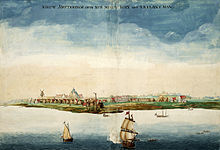
Over the centuries the Netherlands have developed close ties with many countries through trade and colonialism. Shared cultural heritage has evolved in the Netherlands and in these countries. The Dutch involvement with other countries has left traces like art and artefacts, archives, buildings, cities, companies, infrastructure, language, culinary tradition, both in these countries and in the Netherlands. Many collections in GLAM institutions in the Netherlands and these countries show this shared past and the way two cultures influenced each other.
With the project “The Netherlands and the world” Wikimedia Nederland wants to increase free access to knowledge about such shared cultural heritage. And we want to stimulate active participation of GLAM partners and the Wikimedia community, both in the Netherlands and in other countries. We want to develop partnerships and activities, with Wikipedians and Wikimedians worldwide and with knowledge and heritage institututions that want to share and connect relevant collections.
The project is in the start-up phase. We are open to all ideas about activities we can organise, about how the project should be designed or which contacts/ partners are indispensable for this project. We will form an international project group. If you, your organisation, your chapter, thematic organisation or user group is interested in taking part, please let us know.
There is a project page on the Wiki of Wikimedia Nederland.
For more information about the project: contact project coordinator Elisabeth Wiessner wiessner![]() wikimedia.nl
wikimedia.nl
Netherlands in the Europeana Art History challenge
Though there were not many Dutch participants, the Netherlands gained 36 articles in the 280 Europeana Art History challenge that ran from 15 April - 30 May, 2016. For an overview of the articles about the 10 Dutch artworks and the articles about the other 280 artworks of other countries of various Wikipedia language projects, see here.
International Memory of the world register; Speak Norwegian? Access to The National Library's bokhylla.no?
Online editing contest: International Memory of the world register

In May Wikimedia Norge organized an online editing contest about Norges Dokumentarv, the Norwegian documents in the International Memory of the world register which is part of the UNESCOs program Memory of the World. You can see all documents in the register at The Arts Counsil Norway's homepage. 14 new articles were created and 73 references were added. The winner gets a privat tour at The National Archive in Oslo. Still a lot of editing to do on this topic, so we will run the contest again in August, with the same prize. The image shows a document from The National Archive and is the protocoll from Oscarsborg fortress, Oslofjord, on the 9th of April when the ship Blücher was torpedoed and sank.
Speak Norwegian? Access to The National Library's bokhylla.no?

The National Library in Oslo is is digitizing its entire collection. Bokhylla.no is an online service giving users with Norwegian IP addresses access to every book published in Norway up until 2000. Wikimedia Norge can apply on behalf of users without Norwegian IP addresses. Are there any of you who read Norwegian and could have use of this access? Please send my an email before 24.7.2016, astrid![]() wikimedia.no, with name and email address which I need for the application.
wikimedia.no, with name and email address which I need for the application.
Wiki Loves Earth; free resources; Pentathlon Wikimedia
Wiki Loves Earth

For the second time, Wikimedia Spain organized Wiki Loves Earth, a public contest focused, in the Spanish case, on natural areas catalogued as Sites of Community Importance. There were 217 participants and they uploaded 3822 free images of 374 different sites. See complete stats about the contest.
Free pictures and music
In May we covered four events for obtaining pictures and upload them to Wikimedia Commons under a free license. They were the following events: concerts of Abraham Mateo and Andrés Calamaro, the Rally Eurocidade and the Rally of Portugal. Also we recorded 7 more audios of classical music at the Museum of Romanticism, in Madrid. The works are from Claude Debussy and they were performed by the pianist Patrizia Prati.
I Pentathlon Wikimedia

On May 21 the first Pentathlon Wikimedia was organized. It was an activity promoted by Wikimedia Spain, the University of Valencia and the Valencia City Council. The purposes of the organization of the event were:
- Celebrate the 15th anniversary of the Spanish language Wikipedia.
- Celebrate the International Day for Cultural Diversity for Dialogue and Development, since within our chapter and within the projects promote a great diversity, cultural, ethnic, linguistic, functional...
- Reduce the gender gap in the content of Wikipedia.
The event was held at the library Joan Reglà of the University of Valencia and we edited on Wikipedia, Commons, Wikiquote, Wikivoyage and Wikidata.
LSH upload; World Wide Wikipedia; Nationalmuseum
LSH upload

In their continous effort to contribute with all their material, LSH (through André Costa) uploaded 2 677 images. As the cooperation continues, there are now almost 40 000 images uploaded. Take a look through the categories to see if there are images you can put to use in some articles, or if there are any of the maintenance categories you can help clean up or take care of.
World Wide Wikipedia

As a follow up to the tour last fall where the Swedish Exhibition Agency and Wikimedia Sweden hosted a series of workshops focusing on writing about exhibitions, we have now included the National Heritage Board in a two day event called World Wide Wikipedia to be held in four cities in Sweden. On the first day there are presentations from Henrik Summanen, NHB, about new technology and new behaviours, from Lennart Guldbrandsson, long time Wikimedian, about what's going on back stage on Wikipedia and also from Sofie Jonasson, NHB, about Platsr. The second day is a workshop/edit-a-thon where participants can either learn how to edit and upload images or chose to continue editing with a helping hand close by. At the first event, hosted in Stockholm, there were around 35 participants the first day and 21 the second. The tour continues on to Umeå in June and to Malmö and Göteborg in the fall.
Nationalmuseum
Following the data connection and upload earlier this year Nationalmuseum had a training day where staff got to learn how to edit Wikipedia. 18 participants created six new articles and edited another 20. They are planning to start regular workshops for the staff, and also to host a public edit-a-thon sometime in October.
ETH-Bibliothek commences mass uploading campaign for photographs from the Image Archive
ETH-Bibliothek commences mass uploading campaign for photographs from the Image Archive

The uploading project of ETH-Bibliothek's Image Archive conducted in collaboration with Wikimedia CH has got underway, starting with around 350 photographs documenting two flights by Swiss aviation pioneer Walter Mittelholzer (1894–1937):
The trained photographer captured sensational aerial images of landscapes that had never been photographed from a bird’s-eye view before. Used as illustrations in his popular travel guides, the images contributed a great deal to Mittelholzer‘s fame as an aviator, photographer, adventurer and entrepreneur. From today’s perspective, the photographs are also interesting as an image source for (post-)colonial research. Around 134,000 images are scheduled to be uploaded, including additional Mittelholzer photographs and other collections from the ETH-Bibliothek Image Archive’s roughly 340,000 digitised photos:
- Additional photographs by Walter Mittelholzer from his flights over Switzerland and abroad, including Abyssinia, Kilimanjaro and Lake Chad (approx. 18,000 images)
- Portraits of formers members and students of ETH Zurich and famous scientists (approx. 800 images)
- Historical photographs of buildings, institutes, lecture theatres and laboratories at ETH Zurich (approx. 5,000 images)
- The photo archives of the former Swiss airline Swissair (approx. 40,000 images)
- Extensive aerial photograph holdings (approx. 70,000 images)
In the future, we will be listing completed uploads from collections on our user page. We look forward to you using the content provided.
Oxford and Scotland
Oxford
The residency at the Bodleian Libraries has elapsed, but Martin has been finishing the final report and bidding for funding to be Wikimedian In Residence at the University of Oxford. This would involve working across a variety of open access, open culture and open education projects with academic departments and cultural institutions. An outcome on that is due any day now.
The Voltaire Foundation, a department of the University, has been employing Martin to improve open knowledge about Voltaire's works. Wikidata queries have been supremely helpful in getting a picture of how Voltaire is covered on different language versions of Wikipedia: there is generally a skew, in that articles on Voltaire himself and his novel Candide attract a lot of effort, but there are many more of his works which are written about in scholarly literature but are not represented outside French Wikipedia.
Museums Galleries Scotland
Sara Thomas' residency at Museums Galleries Scotland is about to come to an end, but due to a small budget surplus an additional two weeks (and one project with museums and historical societies in the Western Isles) may be possible.
In May, the project extension culminated in the second of two visits to the w:en:Groam House Museum in Rosemarkie. During the first, in April 2016, the resident met with the museum board to present to them about open knowledge, the benefits for small GLAMs, and to gain buy in for more work. The second visit comprised of training for staff, volunteers and board members in editing Wikipedia, and uploading images to Wiki Commons using the new batch uploader for small GLAMs, Pattypan. A test batch of images were uploaded to Commons under the category commons:category:Images from Groam House Museum, with the intention that this will be added to in due course. Plans have also been made for the implementation of a digital licensing policy at the museum. The resident is extremely happy with these results and delighted to have been able to begin to open up the George Bain collection - a Recognised Collection of National Significance to Scotland - to the wider world.
At the end of May the resident trained for two sessions in a late Art+Feminism event with the w:en:Glasgow School of Art. This event created and improved a number of new articles, including one for the last of the artists without a Wiki article whose work features in the Scottish National Portrait Gallery's Modern Scottish Women exhibition. The work of all 45 of these women is now reflected on Wikipedia.
More information about the residency can be found on the project page.
See also
- A related report on Andrew Lih's coverage of the Hay Festival in Wales can be found in the USA newsletter report.
Archivist Award
US National Archives Archivist Award to Andrew Lih
On May 5, Andrew Lih received the Citizen Archivist Award for 2016, from the Archivist of the United States, David Ferriero, at the US National Archives and Records Administration. [6] In the citation for the award, it noted his "outstanding commitment to building a vibrant, participatory culture that spans the National Archives, Academia, and the Wikimedia Community." Since 2014, Lih has taught a class at American University in Washington, D.C., called "Wikipedia and Public Knowledge," that collaborates with GLAM institutions in the nation's capital to improve sections of Wikipedia. The class has worked with the Smithsonian Institution museums and the National Archives for several years, which has fostered to scan-a-thons, meetups and conferences, such as Wikiconference USA 2015 at NARA, where Lih gave the keynote address.
In his email to the Wikimedia DC community, he noted, "Thanks to all the folks at Wikimedia DC over the past year, especially NARA folks such as Dominic Byrd-McDevitt, for supporting all the Wikipedia-oriented work. I view it as an award for all of us, and I am grateful to be working with such a smart and passionate set of folks in DC."
-
Andrew Lih (User:Fuzheado) receiving award.
-
Certificate for the Archivist Award
Computer History Museum exhibit on Wikipedia
The Silicon Valley-based Computer History Museum has confirmed that its exhibit that will highlight Wikipedia is scheduled for opening in January 2017. Andrew Lih's work with the museum dates back to 2010, where he has been a senior advisor to its curatorial staff. In December 2012, a group of Wikipedians held a meetup at the museum to help brainstorm ideas and inform the exhibit's design.
-
Computer History Museum space for the coming Wikipedia exhibit in January 2017.
-
Andrew Lih with curator Marc Weber with exhibit design panels.
Early Modern Edit-a-Thon
On May 13th, the Folger Shakespeare Library hosted an edit-a-thon. The Folger has an internal wiki Folgerpedia, and active transcription project.[7]
Refugees2016

On May 14, 2016, Wikimedia DC partnered with the First Hand Refugee Talks, and Peace Corps volunteers, for an edit-a-thon about refugees, at the Martin Luther King Jr. Memorial Library.
Hay Festival coverage
In a cross-Atlantic collaboration, Andrew Lih attended the prestigious Hay Festival of Books in Wales, in the United Kingdom, and was accredited as a member of the media for contributing content to Wikipedia and Wikimedia Commons. Thanks to Wikimedia UK for helping to facilitate the access. He attended three days of the 11 day festival and photographed high-quality portrait shots of more than a dozen authors and speakers such as Salman Rushdie, Ruby Wax, Caitlin Moran and Juan Gabriel Vasquez to add to their Wikipedia bios. He also worked to improve the articles on Hay Festival (start class) and Hay-on-Wye (B-class).
A full report can be found at en:User:Fuzheado/Hay_Festival_2016
Examples of what the resulting head shots look like in the Wikipedia mobile app.

MENA Artists Month
On April 30, 2016, WMNYC helped with Guggathon, hosted at the Solomon R. Guggenheim Museum to support the month long MENA Artists Month.
Florida Librarians of Wikipedia
Florida Librarians of Wikipedia was officially recognized as a User Group in May. The group was formed by Florida librarians in order to promote the editing of Wikipedia by fellow information professionals. Members of the group participated in an edit-a-thon at the University of South Florida library on April 6 aimed at students and faculty of the USF School of Information.
Ted Speakers Challenge - Win Books!
The TED Speakers Challenge, running until 6 July, stems from the appointment by TED (the "TED Talks" talks people) of two Wikipedians-in-Residence - Jane Darnell (User:Jane023) and yours truly. (See: Meet TED's Wikipedians-in-Residence.)
We're inviting Wikimedians to write or improve Wikipedia articles and Wikidata items about the 1,800+ speakers in the dataset donated by TED as part of the project.
Points are awarded for various types of contributions, and the person with the most points at the end of the challenge will receive a box set of ten TED Books valued at $159.00USD. Ten runners-up will each receive a set of three books. For full details, and to take part, please see TED speakers challenge.
UNESCO and Wiki Loves Earth partner to run Wiki Loves Earth Biosphere Reserves in 120 countries throughout June

UNESCO and Wiki Loves Earth have partnered to create Wiki Loves Earth Biosphere Reserves, a competition to create photographs free for everyone to use and to enrich Wikipedia. The project hopes to help more people learn about the natural world, conservation and sustainability. There are 669 Biosphere Reserves in 120 countries belonging to a World Network of Biosphere Reserves.
Get involved
Because the competition is running across so many countries it has not been possible to run a central notice banner for the competition at the top of Wikimedia pages. Your help is needed to make the project as success, you can:
- Enter the competition with your own photographs, you can find a map of Biosphere Reserves on the website.
- Encourage people to take part by telling people about the project on Wikimedia projects.
- Encourage people to take part on social media by sharing this Facebook message, retweeting this tweet and liking this Instagram photo.
- Translate the website, it is currently available in in English, French, Spanish, Russian and Ukrainian.
- Contact the Biosphere Reserves in your country to tell them about the competition, flyers and other information is available on the website. There are contact details for every reserve on their web pages which can be found using the map on the website.
- Share the competition with photography clubs, universities and any other groups you think may be interested.
- Organise photography expeditions to a Biosphere Reserve near you.
- Create Wikipedia articles from official UNESCO descriptions. UNESCO have made descriptions of their Biosphere Reserves available under CC-BY-SA to help more people learn about them, a guide is available for Wikipedia editors to create missing Wikipedia articles from the descriptions.
WikiCite; Fluorescent vertebrates; Insights into a singer's head
WikiCite
On May 25-26, WikiCite took place in Berlin — an event focused on technical aspects of handling citations and references within and across Wikimedia projects. The topics discussed and worked on ranged from data and metadata models to improving, creating and interlinking workflows. One example is that of OABOT — a tool that scans citations from Wikipedia articles to scholarly publications and tries to identify copies that are free to read. A demo is available here. Another example are ideas for an open citation graph on Wikidata, a demo of which is available for the papers and the respective authors.
Fluorescent fish, MRI while singing, almost extinct fruits
The following represents a selection of the files that have been uploaded this month from open-access sources. Most of these came from PubMed Central through the Open Access Media Importer — whose uploads now total over 21,800. If you can think of wiki pages where these files (or other files from the same source articles) could be useful, please put them in there or let us know.
WMF GLAM report
New GLAM-Wiki Strategist Role
Wikipedia Library lead announced on wikimedia-l and cultural-partners, that former Wikipedia Library project Manager, Alex Stinson, will be filling a new GLAM-Wiki Strategist Role at the Wikimedia Foundation. The role is focused on connecting Wikimedia community members, directing attention for specific needs within the GLAM-Wiki community, and facilitating improvements to technologies, documentation and support throughout the movement. Starting in the June "This Month in GLAM", Alex will be providing regular updates in this column about what he has been working on, and how that might be engaged throughout the community.
We feel used (and that makes us happy)
We make Wikidata so you can use it!
- Mapbox's Geocoder now uses Wikidata
- EveryPolitician: I use Wikidata for multilingual names
- Wikidata through the Eyes of DBpedia
- Wikidata for authority control collects examples of usage of Wikidata IDs for authority control
Tech developments
- Lots of papers relevant to Wikidata or about Wikidata haven been published at ICWSM
- Geospatial search for Wikidata Query Service
- We made a huge step for small Wikipedias and small languages online by rolling out the ArticlePlaceholder
- Sitelinks for the new Jumiekan Patwa Wikipidia (in Jamaican Patois) are being added
- Thesis about editing Wikidata directly from Wikipedia and co
- Guide to using Wikidata (and Wikipedia) data in Google spreadsheet
- Wikiversity now has access to the data on Wikidata
GLAM news
- Meet TED's Wikipedians-in-Residence
- See also this month's special story and win TED books!
- Random item: Q14829494
- Paper: Are Superstar Artworks also Digital Superstars? Online Popularity of Worldfamous Artworks
- Our Main Page now has a section for popular items to show you what is trending on Wikidata based on several people editing an item over the last few days
- The 24,000,000th item was created: Q24000000
- Fun game on Twitter: (digitally) annotating books with Wikidata statements
New GLAM-related properties
- BVMC person ID (Biblioteca Virtual Miguel de Cervantes)
- International Sailing Federation ID
- Australasian Pollen and Spore Atlas Code
- LPGA Tour ID
- PGA Tour ID
- MathWorld identifier
- appears in the heritage monument list
- Yandex.Music album ID
- Belgian Football ID
- Gazetteer of Planetary Nomenclature ID
- via
- Megogo ID
- flower color
- totem
- ARKive ID
- place of marriage
- Benezit ID (Benezit Dictionary of Artists)
- RAN ID (National archaeological register of Romania)
- iTunes artist ID
- Leidse Hoogleraren ID
- Catalogus Professorum Academiae Rheno-Traiectinae ID
- Nederlandse Molendatabase ID
- OpenCritic ID
- Hollandsche Molen ID
- Molenecho's ID
- record or record progression
- time in space
- Library of the National Congress of Argentina ID
Survey results presented at conferences in Hong Kong and Montreal


The widespread digitization of heritage content and the increasing use of social media have triggered many heritage institutions (museums, libraries, archives) to increasingly open up collections and work processes for participation from the outside, as exemplified by open data/open content, social media use, collaborative content creation, and linked data. In order to measure the degree of openness of heritage institutions in various countries, a benchmark survey was developed and administered among heritage institutions in several countries between 2014 and 2016. It has been carried out in a collaborative effort of national chapters of the Open Knowledge Foundation, by Wikimedia chapters, NGOs, heritage institutions, and research institutions, under the lead of the Bern University of Applied Sciences.
Over the past couple of months we presented some of the results of the survey at two international conferences: At the IRSPM 2016 Conference in Hong Kong (IRSPM is the International Research Society for Public Management) in April, and at the International Symposium on the Measurement of Digital Cultural Products, organized by the UNESCO Statistical Office in Montreal, in May.
The Hong Kong paper focuses on the links and mutual influences between various Internet-related practices as well as their dependency on context factors (GDP, E-Participation Index, and the effectiveness of skills acquisition among heritage institutions of a given country). We also show what it means for the institutions to open up their data/content, to use social media to reach their audiences, or to pursue crowdsourcing approaches, by analyzing their goals and motivations, by examining the way they picture their relationship with their publics, and by analyzing the changes in their perceptions as they actually implement these practices on a wider scale.
In the Montreal paper we present some of the key findings of the survey and discuss the strengths and weaknesses, as well as the challenges and opportunities related to the approach chosen to measure ‘open data’, ‘open content’, and related practices within the heritage sector. In order to give an account of the particularities of our approach we compare it to the one used for the ENUMERATE survey, an international study aimed at the measurement of digitization among heritage institutions, and to the one employed for the Open Data Barometer and the Global Open Data Census, two international efforts to survey the advancement of open government data in a large number of countries.
There is a series of insights that can be drawn from the study that are relevant for GLAM outreach work; here the ones I found particularly striking:
- The adoption of OpenGLAM-related practices by heritage institutions of a given country don't appear to be dependent on a country's GDP or on the quality of its IT infrastructure, but much more so on a country's online participation culture.
- The practices of opening up data and content as well as crowdsourcing are here to stay; if the dissemination of ‘open data’ and ‘open content’ continue at the rates suggested by our survey data, we can expect that all the institutions which have centrally managed metadata (i.e. 70% of institutions) will have adopted ‘open data’ in about 10 years and ‘open content’ in about 15 years from now; in the case of crowdsourcing, the data suggest that widespread adoption would take a bit longer.
- Institutions appear to remain skeptical towards the principles of 'open content', even after adopting 'open content. It seems that the change of attitudes follows a change in practice, and not the other way round.
- The structure of the heritage sector in the different countries varies a lot; this should be kept in mind when transferring best practices in outreach from one country to another.
Links to the papers and presentation slides
- Estermann, Beat (2016) "OpenGLAM" in Practice – How Heritage Institutions Appropriate the Notion of Openness. Paper presented at the IRSPM 2016 Conference in Hong Kong. Final Draft. (Presentation).
- Estermann, Beat (2016) OpenGLAM Benchmark Survey – Measuring the Advancement of Open Data / Open Content in the Heritage Sector. Paper presented at the International Symposium on the Measurement of Digital Cultural Products, 9-11 May 2016, Montreal, Canada. Final Draft. (Presentation).
More information about the OpenGLAM Benchmark Survey
Further information about the survey can be found on its project page, including further publications, the questionnaire in the various language versions, as well as the data.
GLAM at Wikimania
Overview of GLAM related submissions as scheduled
| Time | Track | Title | Location |
|---|---|---|---|
| Wednesday 22 June 2016 | |||
| 14.30 - 17:30 | - | Wikimedia Italia event with Archivio Touring | Varenna Villa Monastero |
| Friday 24 June 2016 | |||
| 14.00 - 15.30 | Discussions | What are the movement-wide opportunities for supporting and growing GLAM-Wiki? | School |
| 16.00 - 16.30 | Critical issues: Outreach | The coolest projects of Wikimedia Chapters - be inspired | Hall |
| 16.30 - 17:00 | Critical issues: Outreach | The Archives Challenge | Hall |
| 17.00 - 17.30 | Critical issues: Outreach | How to train future Wikimedians in Residence | Hall |
| Saturday 25 June 2016 | |||
| 11.30 - 12.00 | Critical issues: Outreach | Wiki-wisdom for cultural institutions. Tried and tested formats for GLAMs | Theatre |
| 14.00 - 15.30 | Community village: Training | Historical Maps workshop | Collaborative space |
| 14.30 - 15.00 | User digest | GLAM | Gym palace |
| 15.00 - 15.30 | User digest | Contests | Gym palace |
| 16.00 - 17.30 | Community village: Training | Wikidata and GLAM intermediate workshop | Collaborative space |
| Sunday 26 June 2016 | |||
| 10.30 - 12.00 | Training | Growing a Wikipedia Library Branch | Museum |
| 14.00 - 15.30 | Community village: training | Art and Science of the Editathon Working with organisations to make their content available on Wikimedia |
Collaborative space |
| 14.00 - 14.30 | Critical issues: Contests | How You and the Rest of the Wikimedia Movement Can Help Preserve the World’s Cultural Heritage – or How to Beat the Deadline | Theatre |
| 14.30 - 15.00 | Critical issues: Contests | Present and Future of Wiki Loves Monuments | Theatre |
See also
- See Programme for the full program
June's GLAM events
| <<< previous month | June 2016 | next month >>> | ||||
|---|---|---|---|---|---|---|
| Monday | Tuesday | Wednesday | Thursday | Friday | Saturday | Sunday |
| 30 |
31 |
1 |
2 |
3 |
4 | 5 |
| 6 |
7 |
8 |
9 | 10 | 11 | 12 |
| 13 |
14 |
15 |
16 |
17 |
18 |
19 |
| 20 |
21 | 22 | 23 | 24 | 25 | 26 |
| 27 | 28 | 29 |
30 |
1 |
2 |
3 |



















